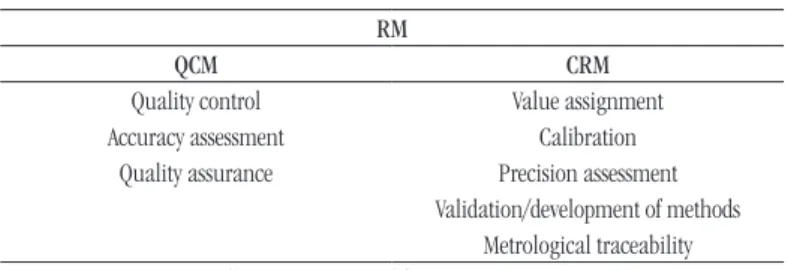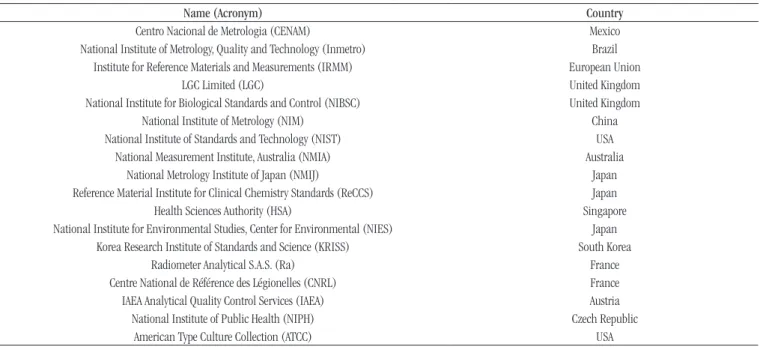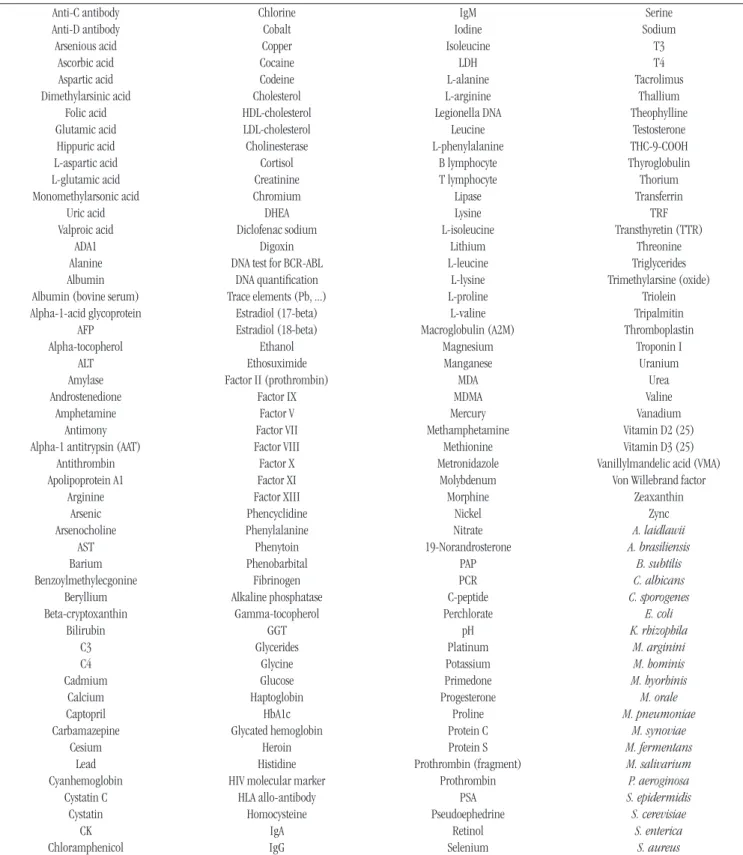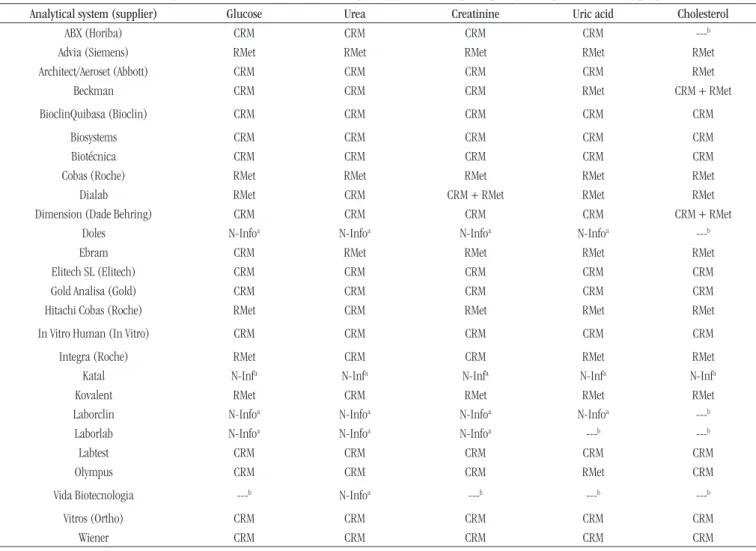Metrological traceability in clinical laboratory
Rastreabilidade metrológica no laboratório clínico
Maria Cristina F. Pessoa1; Orlando C. Ferreira Jr.2
1. Instituto Nacional de Metrologia, Qualidade e Tecnologia (Inmetro), Rio de Janeiro, Brazil. 2. Universidade Federal do Rio de Janeiro (UFRJ), Rio de Janeiro, Brazil.
First submission on 25/02/16; last submission on 25/03/16; accepted for publication on 06/04/16; published on 20/06/16
ABSTRACT
Introduction: Metrological traceability is a little-known and little-discussed metrology theme in clinical laboratories, although it is the basis for comparable results. It is associated with certiied reference material (CRM) and reference method (RMet). When it is used in the supply chain by diagnostic kit manufacturers, it ensures accuracy of the results yielded by laboratories. Objective: This study shows the
availability of information on metrological traceability provided by diagnostic kit manufacturers. Method: It was done with the information
obtained in kits of glucose, urea, creatinine, uric acid and cholesterol participants in a proiciency testing program throughout 2012 and 2013. Results and conclusion: In the research, 18 producers of reference materials (RMs) and 204 measurands available for laboratory medicine were found. In the study of metrological traceability, the preferential use of CRM was demonstrated by kit manufacturers (glucose 60%, urea 69%, creatinine 60%, uric acid 50%, and cholesterol 43%). An important factor is that there are a signiicant number of kits that do not report traceability (glucose 16%, urea 19%, creatinine 16%, uric acid 13%, and cholesterol 5%), although it is a requirement for product registration in Brazil. We hope that this study will contribute to sensitize the laboratory community to the need for a more comprehensive knowledge of this subject, and that it will stimulate institutions involved in the dissemination of knowledge in laboratory medicine to hold discussions on this topic.
Key words: laboratory chemicals; indicators and reagents.
INTRODUCTION
Metrology is the area of knowledge that deals with measurement; it is also known as science of measurement(1, 2). The word comes from the Greek métron, which means measure or evaluate; and logos, reason, study(3). Metrological traceability is a topic in metrology that links a measurement result with a chain of comparisons at the highest level of metrological reliability, promoting comparability of results(1, 4).
Issues related to metrological traceability, such as reference material (RM), certiied reference material (CRM) and reference method (RMet) are little known or discussed in Brazilian clinical laboratories. However, the use of these concepts is associated with the results of measurements made by the laboratory, and is the basis for comparable results between laboratories(4-6).
In clinical laboratories, the term traceability is usually related to quality. In this regard, it is associated with the origin of diagnostic kits, inputs, sample custody chain, or identiication
of professionals involved in the different steps of the analytical process. As already mentioned, another concept of traceability, metrological traceability, is not related to quality, but to measurement(7).
In the context of laboratory medicine, metrological traceability links measurement results of a patient’s sample with a reference, and, thus, makes these measurements comparable among different systems (or assays), places, and times in which they were conducted(4, 8). Metrological traceability is a requirement in all international standards intended for use in clinical laboratories, such as the International Organization for Standardization (ISO) 15189(9), ISO 22870(10) and ISO 17025(11). We can ensure metrological traceability of a test result obtained by a diagnostic kit is by means of CRM or RMet when input and/or diagnostic kits are produced.
These terms have speciic deinitions. RMet is deined in the International Vocabulary of Metrology (VIM)(1) as a measurement procedure considered capable of providing
measurement results adequate for veracity assessment(2). The ISO Guide 30(12) deines RM as “material, suficiently homogeneous and stable with respect to one or morespeciied properties, which has been established to be it for its intended use in a measurement process”; and, CRM as “RM characterized by a metrologically valid procedure for one or more speciied properties, accompanied by an RM certiicate that provides the value of the speciied property, its associated uncertainty, and a statement of metrological traceability”.
RM is a more general term that comprises materials for use in quality control (QCM) and also the CRMs. RMs have several uses and applications (Table 1), according to its characteristics and purpose of use, as calibration of a measurement system, evaluation of a measurement process, validation, veriication, method development, quality assurance, among others(2, 12-15). CRM is a term included in the RM category, with a more speciic use. CRMs are more elaborate materials, characterized by their chemical structures or microbiological species, and by their property values deined by a metrologically valid procedure(15).
are traceable to the International System of Units (SI). It works through the International Committee of Weights and Measures (CIPM), which cooperates with other international organizations responsible for metrology, accreditation, and normalization, such as ISO, International Laboratory Accreditation Cooperation(ILAC) and International Organization of Legal Metrology (OIML). In 2012 BIPM created the Joint Committee for Traceability in Laboratory Medicine (JCTLM), which is responsible for the area of clinical laboratories. In its webpage this committee lists CRM producers and their respective measurands, besides reference methods(20, 21).
In 2000, the metrology institute of the United States, the National Institute of Standards & Technology (NIST), RM producer, published a study over the economic impact of CRM use in cholesterol assays(22). This study demonstrates the importance and the necessity of CRM use by manufacturers of diagnostic kits to ensure accuracy and quality of the results yielded by clinical laboratories. Additionally, the use of CRM decreases production costs of measurement systems, besides ensuring metrological traceability in the supply chain.
OBJECTIVE
Considering this scenario, this work aims at listing the institutions that produce RM for clinical laboratories, and verify the existence of information on metrological traceability of diagnostic kits commercialized in Brazil for the measurands glucose, urea, creatinine, uric acid, and cholesterol.
METHOD
Sources of information about MRC producers and
RMet
For information about MR producers, the international data bases COMAR (www.comar.bam.de) and BIPM (www.bipm.org) were consulted. For information about RMets, JCTLM (www.bipm. org/jctlm) was consulted.
Sources of information about products (CRM)
Consultations on CRM products available for clinical laboratories were hold on the websites of JCTLM (www.bipm.org/ jctlm), COMAR (www. comar.bam.de) and American Type Culture Collection (ATCC) (www.atcc.org).
TABLE 1 − Use associated with RMs RM
QCM CRM
Quality control Value assignment Accuracy assessment Calibration
Quality assurance Precision assessment Validation/development of methods
Metrological traceability Source: ISO Guide 33:2015(2); Emons H (2006)(16).
RMs: reference materials; QCM: quality control material; CRM: certified reference material.
It is important to note that the terms standard, measuring standard, analytical standard, calibration standard, and calibrator used in the clinical laboratory are synonymous with RM(15, 16).
The increasing demand for reliability and accuracy in the results obtained by analytical and metrological techniques have increased the demand for CRM for use in the validation of measurement methods and calibrations(17).
There are currently two international databases that offer information on RM producers and RMets: the Code d’Indexation
des Matériaux de Référence (COMAR)(18) and the Bureau
Information on metrological traceability of
diagnostic kits
Instructions for use of diagnostic kits or calibrators were used to obtain information about metrological traceability. These documents are available on the manufacturers’ websites or were provided by the scientiic advisory body of the diagnostic companies.
Selection of measurands
The option for the measurands glucose, urea, creatinine, uric acid and cholesterol as object of the study was taken because these are biochemical tests ordered in large numbers in clinical laboratories. A second criterion was the ascertainment of the variety of different diagnostic kits commercialized in the diagnostic market for these measurands.
Selection of diagnostic kits
We selected the analytical systems and/or diagnostic kits reported by laboratories participating in a proiciency testing program of ControlLab, to whom we thank for the courtesy of providing these pieces of information. This study was carried out during 2012 and 2013, when results of eight cycles of the program were compiled.
For analysis purposes, the analytical systems and/or diagnostic kits were classiied according to categories of metrological traceability, as follows:
• CRM category – diagnostic kits that use CRM in their manufacturing;
• RMet category – diagnostic kits that use RMet in their manufacturing;
• CRM + RMet category – diagnostic kits that use CRM and RMet in their manufacturing;
• N-Info category – diagnostic kits that did not have metrological traceability or about which it was not possible to obtain information.
Finally, in order to make the article clearer, we presented the deinition of some terms used in this text:
• measurand – means “what is intended to be measured”(1). Synonymous with “analyte”;
• diagnostic kit(23) – group of reagents (kit) that permits the detection or the quantiication of a certain measurand;
• analytical system(9) – group that comprises equipment and a diagnostic kit.
RESULTS
Table 2lists the institutions producers of RMs; Table 3, the analytes (measurands) produced by these institutions.
Table 4 displays the RMets, besides the principles of the methods listed by JCTLM for the studied measurands. Table 5 shows the methods chosen by producers for the investigated analytical systems.
TABLE 2 − RM producers
Name (Acronym) Country
Centro Nacional de Metrologia (CENAM) Mexico
National Institute of Metrology, Quality and Technology (Inmetro) Brazil
Institute for Reference Materials and Measurements (IRMM) European Union
LGC Limited (LGC) United Kingdom National Institute for Biological Standards and Control (NIBSC) United Kingdom
National Institute of Metrology (NIM) China
National Institute of Standards and Technology (NIST) USA National Measurement Institute, Australia (NMIA) Australia
National Metrology Institute of Japan (NMIJ) Japan
Reference Material Institute for Clinical Chemistry Standards (ReCCS) Japan
Health Sciences Authority (HSA) Singapore
National Institute for Environmental Studies, Center for Environmental (NIES) Japan Korea Research Institute of Standards and Science (KRISS) South Korea
Radiometer Analytical S.A.S. (Ra) France
Centre National de Référence des Légionelles (CNRL) France IAEA Analytical Quality Control Services (IAEA) Austria
National Institute of Public Health (NIPH) Czech Republic
American Type Culture Collection (ATCC) USA
Sources: JCTLM, COMAR, and ATCC.
TABLE 3 − List of measurands for which there are RM/CRM
Anti-C antibody Chlorine IgM Serine
Anti-D antibody Cobalt Iodine Sodium
Arsenious acid Copper Isoleucine T3
Ascorbic acid Cocaine LDH T4
Aspartic acid Codeine L-alanine Tacrolimus
Dimethylarsinic acid Cholesterol L-arginine Thallium
Folic acid HDL-cholesterol Legionella DNA Theophylline
Glutamic acid LDL-cholesterol Leucine Testosterone
Hippuric acid Cholinesterase L-phenylalanine THC-9-COOH
L-aspartic acid Cortisol B lymphocyte Thyroglobulin
L-glutamic acid Creatinine T lymphocyte Thorium
Monomethylarsonic acid Chromium Lipase Transferrin
Uric acid DHEA Lysine TRF
Valproic acid Diclofenac sodium L-isoleucine Transthyretin (TTR)
ADA1 Digoxin Lithium Threonine
Alanine DNA test for BCR-ABL L-leucine Triglycerides
Albumin DNA quantiication L-lysine Trimethylarsine (oxide) Albumin (bovine serum) Trace elements (Pb, ...) L-proline Triolein
Alpha-1-acid glycoprotein Estradiol (17-beta) L-valine Tripalmitin
AFP Estradiol (18-beta) Macroglobulin (A2M) Thromboplastin
Alpha-tocopherol Ethanol Magnesium Troponin I
ALT Ethosuximide Manganese Uranium
Amylase Factor II (prothrombin) MDA Urea
Androstenedione Factor IX MDMA Valine
Amphetamine Factor V Mercury Vanadium
Antimony Factor VII Methamphetamine Vitamin D2 (25)
Alpha-1 antitrypsin (AAT) Factor VIII Methionine Vitamin D3 (25)
Antithrombin Factor X Metronidazole Vanillylmandelic acid (VMA)
Apolipoprotein A1 Factor XI Molybdenum Von Willebrand factor
Arginine Factor XIII Morphine Zeaxanthin
Arsenic Phencyclidine Nickel Zync
Arsenocholine Phenylalanine Nitrate A. laidlawii
AST Phenytoin 19-Norandrosterone A. brasiliensis
Barium Phenobarbital PAP B. subtilis
Benzoylmethylecgonine Fibrinogen PCR C. albicans
Beryllium Alkaline phosphatase C-peptide C. sporogenes
Beta-cryptoxanthin Gamma-tocopherol Perchlorate E. coli
Bilirubin GGT pH K. rhizophila
C3 Glycerides Platinum M. arginini
C4 Glycine Potassium M. hominis
Cadmium Glucose Primedone M. hyorhinis
Calcium Haptoglobin Progesterone M. orale
Captopril HbA1c Proline M. pneumoniae
Carbamazepine Glycated hemoglobin Protein C M. synoviae
Cesium Heroin Protein S M. fermentans
Lead Histidine Prothrombin (fragment) M. salivarium
Cyanhemoglobin HIV molecular marker Prothrombin P. aeroginosa
Cystatin C HLA allo-antibody PSA S. epidermidis
Cystatin Homocysteine Pseudoephedrine S. cerevisiae
CK IgA Retinol S. enterica
Chloramphenicol IgG Selenium S. aureus
Sources: JCTLM, COMAR, and ATCC.
Table 6 presents the informed metrological traceability reported by the laboratories participating in the proiciency testing program of ControlLab, in 2012 and 2013, for the studied measurands. The
Figure is a summary of Table 6, presenting the percentages of analytical systems that use CRM, RMet, CRM + RMet, and N-Info.
DISCUSSION
In the survey of RM producers and products made available for the area of clinical laboratory, 18 institutions (Table 2) and 204 analytes (Table 3) produced by these institutions were found,
TABLE 4 − List of RMets for the measurands glucose, urea, creatinine, uric acid, and cholesterol
Measurand Reference method/procedure Method principle
Glucose Japan Society of Clinical Chemistry German Society of Clinical Chemistry National Institute of Standards & Technology
University of Ghent Center for Disease Control and Prevention
Enzymatic ID/GC/MS ID/GC/MS ID/GC/MS Spectrophotometry
Urea German Society of Clinical Chemistry National Institute of Standards & Technology
Center for Disease Control and Prevention
ID/GC/MS ID/GC/MS Spectrophotometry
Creatinine German Society of Clinical Chemistry National Institute of Standards & Technology
University of Ghent National Institute of Metrology (China)
Org-022
Isotope dilution LCMS surface enhanced Raman scattering (ID/SERS)
ID/GC/MS ID/GC/MS, ID-LC/MS
ID/GC/MS ID/LC/MS, ID/LC/MS/MS
ID-LC/MS ID/SERS
Uric acid German Society of Clinical Chemistry National Institute of Standards & Technology
University of Ghent National Institute of Metrology (China)
ID/GC/MS ID/GC/MS ID/GC/MS ID/LC/MS, ID/LC/MS/MS
Cholesterol NCCL
Centers for Disease Control and Prevention German Society of Clinical Chemistry National Institute of Standards & Technology
University of Ghent Org-005 CDC Abell-Kendall method
HPLC, ID-LC/MS/MS ID/GC/MS ID/GC/MS ID/GC/MS ID/GC/MS Isotope dilution LCMS
Spectrophotometry Source: List of BIPM/JCTLM(20).
RMets: reference methods.
TABLE 5 − RMets used in the analytical systems of the investigated glucose, urea, creatinine, and cholesterol
System (supplier) Glucose Urea Creatinine Uric acid Cholesterol
Advia (Siemens) NCCLS NCCLS; enzymatic AACC, HPLC CDC, uricase NCCLS; Abell-Kendall modiied
Architect/Aeroset (Abbott) ---a ---a ---a ---a Abell-Kendall
Beckman ---a ---a ---a - ID-MS and CDC
Cobas (Roche) ID-MS ID-MS ID-MS ID-MS ID-MS or Abell-Kendall
Dialab ID-MS ---a CG-IDMS GC ID-MS GC ID-MS
Dimension (Dade Behring) ---a ---a ---a ---a Abell-Kendall of CDC
Ebram ---a CLSI CLSI CLSI CLSI
Hitachi Cobas (Roche) ID-MS ---a ID-MS ID-MS ID-MS or Abell-Kendall
Integra (Roche) ID-MS ---a ---a ID-MS ID-MS and Abell-Kendall
Kovalent ID-MS ---a GC-IDMS GC ID-MS GC ID-MS
Olympus ---a ---a ---a ID-MS Abell-Kendall
Source: Information from package inserts/instructions, or provided by the diagnostic enterprises.
TABLE 6 − Metrological traceability of analytical systems reported by laboratories participating in the proficiency testing program
Analytical system (supplier) Glucose Urea Creatinine Uric acid Cholesterol
ABX (Horiba) CRM CRM CRM CRM ---b
Advia (Siemens) RMet RMet RMet RMet RMet
Architect/Aeroset (Abbott) CRM CRM CRM CRM RMet
Beckman CRM CRM CRM RMet CRM + RMet
BioclinQuibasa (Bioclin) CRM CRM CRM CRM CRM
Biosystems CRM CRM CRM CRM CRM
Biotécnica CRM CRM CRM CRM CRM
Cobas (Roche) RMet RMet RMet RMet RMet
Dialab RMet CRM CRM + RMet RMet RMet
Dimension (Dade Behring) CRM CRM CRM CRM CRM + RMet
Doles N-Infoa N-Infoa N-Infoa N-Infoa ---b
Ebram CRM RMet RMet RMet RMet
Elitech SL (Elitech) CRM CRM CRM CRM CRM
Gold Analisa (Gold) CRM CRM CRM CRM CRM
Hitachi Cobas (Roche) RMet CRM RMet RMet RMet
In Vitro Human (In Vitro) CRM CRM CRM CRM CRM
Integra (Roche) RMet CRM CRM RMet RMet
Katal N-Infa N-Infa N-Infa N-Infa N-Infa
Kovalent RMet CRM RMet RMet RMet
Laborclin N-Infoa N-Infoa N-Infoa N-Infoa ---b
Laborlab N-Infoa N-Infoa N-Infoa ---b ---b
Labtest CRM CRM CRM CRM CRM
Olympus CRM CRM CRM RMet CRM
Vida Biotecnologia ---b N-Infoa ---b ---b ---b
Vitros (Ortho) CRM CRM CRM CRM CRM
Wiener CRM CRM CRM CRM CRM
Source: package inserts of diagnostic kits.
CRM: certified reference method; RMets: reference methods; N-Infoa: no information about the use of CRM or RMet; b:the diagnostic kit does not appear in the investigated ControlLab
reports.
16% 50%
38% 38%
43%
14%
5% 0%
13%
Uric acid Cholesterol
N-Inf
FIGURE − Traceability of the analytical systems reported by the laboratories participating
in the proficiency testing program of ControlLab, for determinations of glucose, urea, creatinine, uric acid, and cholesterol, during 2012 and 2013
CRM: certified reference material; RMet: reference method; N-Info: no information on the use of CRM or RMet.
Traceability
60%
24%
0% 16%
Glucose 69%
12%
0% 19%
Urea
60%
20%
4%
Creatinine
CRM + RMet RMet
CRM
but not all RM products are registered in the databases COMAR and/or BIPM. For these cases, the survey was conducted directly on the producers’ websites, for example, on ATCC.
such as, for instance, isotope dilution mass spectrometry (ID-MS); others, the institution that developed the method, for example, the Centers for Disease Control and Prevention (CDC). We could also observe that there are package inserts with outdated information, such as that of the analytical system Advia for the measurand glucose, which refers to CLSI mentioning the old acronym NCCLS.
In the metrological traceability informed through the use of CRM, RMet, CRM + RMet, and N-Info of analytical systems for determinations of glucose, urea, creatinine, uric acid, and cholesterol (Table 6 and Figure), we could observe that metrological traceability was presented at a higher percentage by the use of CRM (glucose 60%, urea 69%, creatinine 60%, uric acid 50%, and cholesterol 43%), and that an expressive number of analytical systems (glucose 16%, urea 19%, creatinine 16%, uric acid 13%, and cholesterol 5%) do not inform traceability.
Nowadays there is an international movement for the development of a measurement system reference, which encompasses CRM and RMet. Metrological traceability is considered one of the most important tools for the support of this process(24), what stimulates us to know and discuss this subject further.
CONCLUSION
Most of the 18 CRM producers are metrology institutes, and the number of RMs made available for clinical laboratories
(a total of 204 measurands) is small contrasted with the number of conducted tests.
Concerning information on metrological traceability, most suppliers use CRM. There is an expressive number, ranging from 5% to 19%, of commercialized products in Brazil, which do not inform traceability, what reveals the little importance given to this piece of information by some diagnostic enterprises.
The laboratory community, including professionals that are part of them, is badly acquainted with the terms and concepts of metrological traceability and with its importance in laboratory results – although metrological traceability is a requirement in international guidelines applied to laboratories and in the national norm that rules product registration (RDC nº 206/2006).
This theme should be further discussed and studied by all the involved groups; and institutions related to the dissemination of knowledge in the area of clinical laboratories should make an effort to promote discussions about this issue.
We hope this study contributes to sensitize the laboratory community to the need for a more encompassing knowledge of the process of laboratory result production. We call special attention to the prior critical analysis of the diagnostic kits chosen by laboratories for routine use and the implications of this choice in their results.
RESUMO
Introdução: Rastreabilidade metrológica é um tema da metrologia pouco conhecido e discutido nos laboratórios clínicos,
apesar de ser a base para resultados comparáveis; associa-se a material de referência certificado (MRC) e a método de referência (MetR). Quando usada na cadeia de suprimentos pelos fabricantes de conjuntos diagnósticos, atua na garantia da exatidão dos resultados produzidos pelos laboratórios. Objetivo: Apresentar a disponibilidade das informações sobre rastreabilidade metrológica fornecidas pelos fabricantes de conjuntos diagnósticos. Método: O estudo foi feito com as informações obtidas nos conjuntos diagnóstico de glicose (GLI), ureia (URE), creatinina (CRE), ácido úrico (AU) e colesterol (COL) participantes de um programa de ensaio de proficiência ao longo de 2012 e 2013. Resultados e conclusão: Na pesquisa sobre produtores de materiais de referência (MRs) e de produtos disponibilizados, foram encontrados 18 produtores e 204 analitos para a área de laboratórios clínicos. No estudo sobre rastreabilidade metrológica, foi demonstrado o uso preferencial de MRC pelos fabricantes de conjuntos diagnósticos (GLI 60%; URE 69%; CRE 60%, AU 50% e COL 43%), bem como o dado importante de que há um número expressivo de conjuntos diagnósticos que não informa rastreabilidade (GLI 16%; URE 19%; CRE 16%, AU 13% e COL 5%), embora ela seja requisito em norma nacional que regulamenta o registro de produtos. Esperamos que este estudo contribua para sensibilizar a comunidade laboratorial da necessidade de conhecimento mais abrangente acerca deste assunto e que estimule as instituições relacionadas com a disseminação de conhecimento na área de laboratório clínico a promover discussões sobre o tema.
CORRESPONDING AUTHOR
Maria Cristina Ferreira Pessoa
Rua Prefeito João Felipe, 537, apto 103; Santa Teresa; CEP: 20251-140; Rio de Janeiro-RJ, Brasil; e-mail: cristinafpessoa@hotmail.com.
REFERENCES
1. Instituto Nacional de Metrologia, Qualidade e Tecnologia (Inmetro). Brasil. Vocabulário Internacional de Metrologia – conceitos fundamentais e gerais e termos associados (VIM 2012) [Internet]. 1 ed. Luso-Brasileira; 2012. Available at: http://www.inmetro.gov.br/inovacao/publicacoes/ vim_2012.pdf.
2. International Organization for Standardization (ISO). ISO Guide 33:2015 – Reference materials – Good practice in using reference material; 2015.
3. Instituto Nacional de Metrologia, Qualidade e Tecnologia (Inmetro). Brasil. História e Evolução da Metrologia. Programa de integração de servidores; 2011: 6.
4. Vesper HW, Thienpont LM. Traceability in laboratory medicine. Clin Chem. 2009; 55(6): 1067-75.
5. Zakaria O, Rezali MF. Reference materials as a crucial tools for validation and veriication of the analytical process. Procedia - Social and Behavioral Sciences. 2014; 121: 204-13.
6. Bureau International des Poids et Mesures (BIPM), Joint Committee for Traceability in Laboratory Medicine (JCTLM). Paris. Available at: http:// www.bipm.org/jctlm/JCTLM_Database_Lealet.pdf.
7. Associação Brasileira de Normas Técnicas (ABNT). ABNT NBR ISO 9000:2005. Sistemas de gestão da qualidade – Fundamentos e vocábulos; 2005.
8. Associação Brasileira de Normas Técnicas (ABNT). ABNT NBR NM ISO 17511:2010. Produtos médicos para uso em diagnóstico in vitro – medição de quantidades em amostras biológicas – rastreabilidade metrológica de valores designados a calibradores e materiais de controle (ISO 17511:2003, IDT); 2010.
9. Associação Brasileira de Normas Técnicas (ABNT). ABNT NBR ISO 15189:2015. Laboratórios clínicos: requisitos de qualidade e competência; 2015.
10. Associação Brasileira de Normas Técnicas (ABNT). ABNT NBR NM ISO 22870:2006. Laboratórios clínicos – teste laboratorial remoto (TLR) – requisitos para a qualidade e competência; 2006.
11. Associação Brasileira de Normas Técnicas (ABNT). ABNT NBR ISO/ IEC 17025:2005. Requisitos gerais para a competência de laboratórios de ensaio e calibração; 2005.
12. International Organization for Standardization (ISO). ISO Guide 30:2015. Reference materials -- Selected terms and deinitions; 2015.
13. Moura SS, Costa SRR. Estudo da utilização de materiais de referência nas análises de água por laboratórios envolvidos no sistema de acreditação. Production. 2009; 19(2): 304-16.
14. European Cooperation for Accreditation. EA-4/14 INF:2003. The selection and use of reference materials; 2003.
15. Instituto Nacional de Metrologia, Qualidade e Tecnologia (Inmetro). Coordenação Geral de Acreditação (Cgcre) – Brasil. DOQ-CGCRE-016. Orientação para seleção e uso de materiais de referência. Revisão 2; 2010.
Available at: http://www.inmetro.gov.br/credenciamento/organismos/
doc_organismos.asp?tOrganismo=AvalLAB.
16. Emons H. The ‘RM family’ – Identiication of all of its members. Accreditation and Quality Assurance. 2006; 10(12): 690-1.
17. Associação Brasileira de Normas Técnicas (ABNT). ABNT ISO GUIA 31. Materiais de Referência – conteúdo de certiicados e rótulos. 2 ed; 2004. 18. COde d’Indexation des MAtériaux de Référence (COMAR). Alemanha.
Available at: http://www.comar.bam.de/home/login.php.
19. Bureau International des Poids et Mesures (BIPM), Joint Committee for Traceability in Laboratory Medicine (JCTLM). Paris. Available at: http://www.bipm.org/jctlm/.
20. Bureau International des Poids et Mesures (BIPM), Joint Committee for Traceability in Laboratory Medicine (JCTLM). Paris. JCTLM Database Newsletter [internet]. Issue 1; April, 2014. Available at: http://www.bipm. org/en/committees/jc/jctlm/#newsletter.
21. Armbruster D, Miller RR. The Joint Committee for Traceability in Laboratory Medicine (JCTLM): a global approach to promote the standardisation of clinical laboratory test results. Clin Biochem Rev. 2007; 28(3): 105.
22. National Institute of Standards & Technology (NIST). USA. Planning, Strategic. The Economic Impacts of NIST Cholesterol Standards Program. Economic Analysis; 2000. Available at: http://www.nist.gov/director/ planning/upload/report00-4.pdf.
23. Ministério da Saúde. Agência Nacional de Vigilância Sanitária (ANVISA). Secretaria de Vigilância em Saúde, Departamento de DST, Aids e Hepatites Virais. Manual técnico para o diagnóstico da infecção pelo HIV. 2013. Available at: http://www.aids.gov.br/sites/default/iles/ anexos/publicacao/2013/55594/_p_manual_tecnico_hiv_final_ pdf_p__23462.pdf.




